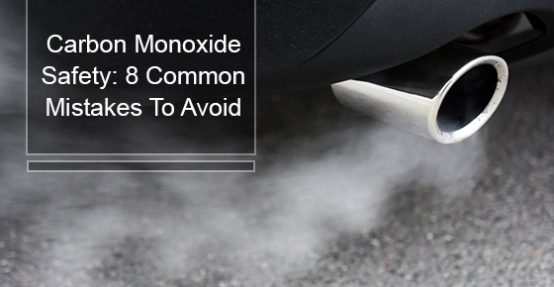
Carbon monoxide poisoning can be deadly for both humans and animals. About 20 percent of the people who are accidentally exposed to this deadly gas lose their lives, while 10-15 percent develop long-term complications, such as brain damage or heart problems.
How is carbon monoxide produced in your home?
Carbon monoxide (CO) is produced by the incomplete combustion of all materials containing carbon. In your home, it is produced by operating appliances that are fuelled with liquefied petroleum (LP gas), oil, wood, kerosene, coal, or natural gas. These include furnaces, gas stoves, space heaters, chimneys, refrigerators, portable grills, and water heaters, as well as non-electric machines such as cars or lawn mowers. A major gas leak can also result in CO poisoning.
Normally, any CO released by heating equipment or the furnace in your home is vented outside so it doesn’t accumulate indoors to toxic levels. But when the air circulating in your rooms and heating systems is not vented correctly, or when there is a leakage that results in a higher rate of CO buildup than of venting, then you can inhale more carbon monoxide than oxygen, resulting in CO poisoning – when normal oxygen supply to the tissues is inhibited.
Risks of Carbon Monoxide Leakage
Carbon Monoxide is hard to detect until it is too late. It is colourless, odourless, and tasteless, plus the symptoms of inhaling the gas are non-specific. This is why it’s often referred to as the ‘silent killer’. Certain groups of people, including unborn babies, infants, and those with respiratory problems, chronic disease, or anaemia, are more susceptible to the effects.
So, what are some of the things that could increase the risk of CO leak?
Lack of a carbon monoxide detector
A carbon monoxide detector is a very important gadget for every home. It is designed to sound an alarm if abnormal levels of CO are detected in the air. Make sure that you buy quality detectors that have been approved by the governmental health and safety institutions. They’re affordable, so you can buy multiple CO detectors to install in all communal areas – living room and kitchen – as well as in each bedroom for quick detection of CO leaks.
Make sure to install a battery-operated detector at least five-feet away from any burning appliances to avoid false alarms. Check and replace the batteries at least twice a year.
Although CO detectors have become standard in most homes today, it is still important to try and eliminate any risks that may lead to carbon monoxide poisoning in case the detector has a problem or there’s a person with special needs in your home who may not be able to respond appropriately to the alarm.
Poor ventilation
Owing to the nature of carbon monoxide gas, it is very difficult to detect CO buildup. However, you can prevent some risks by ensuring that your appliance are well-ventilated. Avoid placing or using appliances in tight spaces where there’s insufficient air circulation. For instance, you shouldn’t idle your car in the garage, and especially not with the garage doors closed. This can easily fill up your garage and home with CO.
Also don’t use portable flameless chemical heaters, portable gas stoves, barbecue/charcoal grills indoors, or burn anything in a fireplace or stove that is not vented.
Blocked chimney
Chimneys often get blocked by debris, which can cause CO to build up inside. Fortunately, this can be easily prevented by having the chimney inspected and cleaned annually. Check indicators like the lack of an upward draft in flue, fallen soot in the fireplace, or smoke, fumes, soot, or back-draft inside the house.
Poor appliance installation, maintenance, and/or repair
Gas leaks resulting from faulty, poorly fitted, or badly maintained appliances like cookers and boilers is a primary cause of CO poisoning. Any of these reasons could allow the hydrocarbon gas to escape, probably from a broken seal or poorly attached gas hose connecting to the appliance.
You can eliminate this risk by ensuring that your appliances are professionally installed and serviced routinely by a reputable and licensed contractor.
Buying low-quality, second hand appliances
Be cautious when purchasing second-hand appliances. Inspect them before installation, and watch out for signs of a leak, such as:
CO leaks are hard to detect and deal with, so it’s best to stop them from occurring in the first place. Be careful when buying, installing, and using second-hand appliances, and watch out for carbon monoxide signs in order to take prompt action.
Using the oven to warm your rooms
Never use an oven or gas range for heating as it can cause CO to build up inside your home, camper, or cabin.
Mediocre repairs
If the vent pipes are damaged or have a leak, don’t do messy patch work with tape or gum. Get a professional to fix it instead.
Poor management of CO emissions
When using a generator, don’t put it inside your home, garage, or basement, or near a vent, window, or door. Put it at a safe distance from any air inlet in your home. Also make sure to use any outdoor stoves at a fair distance from your home to prevent the CO from coming in.
Carbon monoxide safety
When it comes to protecting yourself from carbon monoxide poisoning, you should ensure that all the heating appliances/equipment, vents, and chimneys are inspected at least once a year. Also install quality CO detectors in different rooms around your home, and test them regularly. Lastly, only use grills and burners, and run gas/fuel-powered equipment in well ventilated areas.
If you’re late to detect CO leakage, you may experience dizziness, weariness, tightness across the forehead, and mental changes. These are signs of CO poisoning, and you should seek treatment as soon as possible.
© 2024 Licensed Electrical Installation & Service – Hi-Liteelectricinc.ca
All Rights Reserved.
Leave A Comment